Absconding
One of the few principles I have ( ? ) is that the posts here should be based upon practical experience. When I write about swarm control I describe the methods that I use. When I write about Varroa management I discuss Apivar and oxalic acid in detail as I have a lot of experience using these compounds. I’ve not written about MAQS as I don’t use it.
For the same reasons, you won’t see a discussion about top bar hives or the Bee Guardian piezoelectric gadgets that causes “the varroa mites stop to reproduce and go away from the hive” {{1}}.
The topic today is absconding. My qualification to write about this is extremely limited, but just about sufficient. I think I’ve had only one colony abscond in the last decade. It’s not something I take any notice of (or precautions against) in my regular beekeeping. However, it’s an interesting subject as there’s some relevant science associated with absconding and honey bee migration, so it’s worth discussing.
And perhaps more science to do …
But first some definitions
Colony reproduction involves swarming. The colony rears one or more new queens. Once the queen cells are capped, the current queen and up to 75% of the adult bees leave the hive as a swarm. Prior to leaving, scout bees have scoured the environment for suitable new nest sites. These scouts lead the swarm to the chosen new location {{2}}.
The swarm leaves behind all the brood and most of the stores. Together with the adult bees that remain, this colony has a good chance of survival (~80%) which is probably a reflection on queen mating success rates {{3}}.
‘Most of the stores’ because the swarming bees gorge themselves on honey prior to leaving the hive (or nest site if it’s a feral colony). Something like 40% by weight of the swarm is honey stores. They need these stores to survive – to build new comb, to tide them over a period of bad weather and while they scout the environment for forage. Swarming is a risky business, only about 20% of natural swarms survive.
Absconding is very different. During this process the entire colony – the queen and all the flying bees – leave the nest site (hive). They usually leave behind almost nothing. There may be very limited amounts of capped brood/larvae or eggs remaining, but the stores are usually gone. Absconding therefore does not involve colony reproduction. There are no queen cells produced. You start with one colony and end with one.
However, although absconding is very different, it’s not completely different. It still involves scout bees and it still involves waggle dances to communicate distance and direction.
Like swarming, it’s also a completely natural process. In certain parts of the world there are annual cycles of absconding and colony migration.
In the discussion that follows I’m going to try and make a distinction between absconding by managed and unmanaged colonies.
The consequences of either type of colony absconding are probably the same.
The drivers that result in the colony absconding are sometimes different.
My experience
Let’s get this out of the way … {{4}}
To my knowledge the only colony I have ever had abscond was from a Kieler mini-nuc. The mini-nuc had been primed with a mugful of bees and a queen cell a week or so earlier. The queen had emerged and may (or may not?) have gone on a mating flight {{5}}.
One baking hot June afternoon I turned up at the apiary just as a small swirling mass of bees disappeared over the fence.
Never to return ?
The mini-nuc was low on stores (but far from empty) and devoid of bees (or brood). There was drawn comb so the queen would have been able to lay (if she had been mated). I can’t remember whether there were eggs present … this was several years ago {{6}}.
‘Natural’ absconding and colony migration
This mini-nuc wasn’t the one pictured, but it was similarly exposed. In full sun these can rapidly overheat and there is a real risk of the small colony absconding. I now always site my mini-nucs out of the heat of the full sun – even in Scotland – in dappled shade, at the bottom of a hedge or somewhere similar.
Of course, I don’t know that overheating caused this little colony to abscond, but it seems like a reasonable assumption.
Bees living in temperate and tropical regions exhibit gross behavioural differences that reflect the climate and availability of forage. Those in temperate climates swarm annually, coinciding with the predictable period of forage availability, and are quiescent over ‘winter’.
In contrast, bees in tropical climates have no ‘winter’ to survive as the temperature is high enough all year for brood rearing and comb building. What differs though is the availability of forage and water. If these are limiting the bees migrate to other areas.
This annual migration involves the colonies absconding … and it has been quite well studied by scientists.
Adverse environmental conditions are one of the recognised drivers of absconding. In addition to overheating, these include a dearth of resources during the wet season.
The other major driver of absconding is disturbance, for example by predators such as ants (or beekeepers). Disturbance is a lot less predictable than environmental factors, and it is the latter that has been better studied.
Preparing to migrate
Absconding and migration appear to be a characteristic of strong, healthy colonies. Prior to absconding the colony reduces brood rearing drastically although the queen continues to lay a very limited number of eggs until the bulk of the worker brood has emerged {{7}}.
Colonies tended to abscond within a day of this worker brood emerging, leaving almost nothing in the original nest site.
So, this isn’t a spur of the moment decision, it’s a protracted process taking at least a fortnight from the near-cessation of brood rearing. This means the colony benefits from the resources they have invested in rearing brood, rather than leaving behind slabs of capped brood that would otherwise be doomed.
How does the colony know where to go when it absconds?
Actually, these preparations probably take more than a fortnight. Analysis of the waggle dances for several weeks prior to absconding show that the foraging area and distances were both increasing and becoming more variable.
Schneider and McNally {{8}} showed that these waggle dances regularly communicated distances of up to 20 km from the nest site.
However, these weren’t typical dances … the distance component was variable, the dance occurred during periods of little flight activity and the dance was not associated with forage sources. They interpreted this as a generalised signal to fly for a long (but unspecified) distance in a particular direction, rather than to a specific location.
I’m not aware of follow-up studies to these. Do the bees go through the same sort of decision-making process to ‘agree’ on the final direction as the scout bees do when a colony swarms? I suspect not, the distance component was very variable and there was no direct evidence that the dancing bees ever made the entire journey anyway.
Perhaps these waggle dances simply indicate “Things are better a long way south of here. When we go, that’s the direction to take”.
Stopovers
If a colony absconds due to adverse environmental conditions – such as a lack of forage, or overheating – it seems unlikely that things would be much better only 20 km away. “environment” is local, but not necessarily that local.
In reality, colonies abscond and migrate much further than this when necessary, resting in temporary stopover locations when necessary. In the case of Apis mellifera I’m not aware of any studies of these sites. However, in the Giant honey bee (Apis dorsata) some of these stopover locations appear to be re-used annually.
Apis dorsata migrates up to 200 km and has even been reported crossing 50 km of open water between Sumatra and Malaysia. These long migrations take up to a month and the bees bivouac on trees, resting and replenishing their stores (by foraging locally) {{9}}.
Analysis of scout bee dancing activity on the surface of these bivouacked colonies show that this again determines the direction (and possibly distance) of the next stage of the journey.
Absconding and managed colonies
I think it’s reasonable to assume that at least some of the factors that induce colonies to abscond in tropical regions also trigger absconding in our managed colonies in the UK.
Very small colonies – like the mini-nuc described above – are poor at thermoregulation. There are simply too few bees present to cool the colony in very hot weather.
Although I’m aware that colonies may abscond due to disturbance – from wax moth, Varroa or small hive beetle infestation – I’ve no experience of this {{10}}.
What about disturbance by beekeepers managing colonies? It’s a possibility I suppose. Clearly the regular weekly inspections are not sufficient disturbance to trigger absconding, but perhaps a daily rummage through the brood box might not be tolerated {{11}}.
Absconding swarms
In temperate climates most beekeepers associate absconding with recently hives swarms.
Here’s a typical scenario …
The beekeeper is called out to a bivouacked swarm hanging – conveniently and precariously, just out of reach – in a tree.
By the time they’ve collected the ladder, the skep, the white sheet and the secateurs it’s late afternoon. Never mind … A swarm in May is worth a bale of hay etc.
They drop the swarm into the skep, avoid toppling off the ladder, allow the flying bees to join the queen, wrap everything in the sheet and return triumphantly to their apiary {{12}}.
In time honoured tradition they assemble a new hive, prop the entrance open and build a sheet-covered ramp onto which they unceremoniously dump the collected swarm.
And the bees calmly walk up the slope into the hive.
It’s one of the great sights in beekeeping … and one I now never bother to do.
I just dump the swarm into the hive and close it up.
Boring, but quick ?
Back to the absconding swarm scenario …
The beekeeper returns late the following morning to find the swarm has gone ?
Is this typical absconding?
Other than one or two typical circumstances such as a freshly painted (and still smelly) hive, I think that these swarms may abscond because they have already chosen an alternative nest site.
The scout bees from the bivouacked colony (collected a day or two previously) had been busy surveying the environment for suitable nest sites. This process can take several days until a sufficient number of the scouts are convinced of the benefits of a particular site.
Once that decision is made the colony leaves the bivouac and flies to the new nest site. However, this flight tends to happen in the middle of the day, not late in the afternoon.
The beekeeper who hived our hypothetical swarm in the scenario above may have actually interrupted this process, which simply continued the following morning.
I don’t know if scout bees conduct waggle dances overnight to reinforce nest site choices (but the normal waggle dance for forage resources can occur during the night). If they do, this might account for the bees disappearing soon after being hived.
How do you stop hived swarms absconding?
There are three methods I’m aware of.
One is foolproof and I use every season. The other two are reported to work with variable levels of success, but which I have never used.
Adding a frame of open brood is reported to help stop the colony absconding. Alternatively, placing a queen excluder under the brood box (but above the floor) ‘traps’ the queen and prevents the colony leaving.
The first of these provides brood to care for, brood pheromones and the general ‘pong’ of a hive, all of which are likely to be beneficial. As I’ve not used this method I’m unsure how effective it is.
The queen excluder seems a heavy-handed and rather crude solution. The colony may well still try and abscond, but the queen will remain trapped. This seems like a great way to induce considerable stress in the colony.
And it’s unlikely to be successful long-term if the swarm is a cast with a virgin queen ?
And the totally foolproof method?
I’ve never had a swarm that voluntarily arrived in a bait hive abscond. Even if I move the bait hive to another apiary, they still happily stay ?
Citizen science
I almost never hive bivouacked swarms these days as I am sufficiently successful in attracting swarms with bait hives {{13}}.
I’m therefore unable to conduct the following experiment that I think would be quite interesting.
I’ve predicted above that a swarm collected from a bivouac that absconds may have already decided on the new nest site. By ‘hiving’ the swarm all the beekeeper is doing is moving the bivouac.
That being the case, I’d expect that collected swarms would be less likely to abscond if they’re moved to an area the scout bees have no knowledge of.
Scout bees survey the environment at least 3 km from the original nest site although swarms tend to occupy new nest sites well within this distance.
There are two things that would be interesting to monitor:
- Are swarms hived over 8 km from the location the swarm is collected less likely to abscond?
- Is the delay between hiving a swarm and it absconding related to the distance between the original bivouac and the initial location it is hived in?
I’ve chosen 8 km because you cannot always be certain where the bivouacked swarm came from (and because it’s a convenient 5 miles for these post-Brexit times). If you assume that the bivouac is always within a few dozen metres of the original nest site this ‘removal’ distance could be decreased to about 4 km.
The time delay addresses a slightly different question. I’m assuming here that the scout bees have yet to reach a quorum decision and are continuing to survey the environment. The further you move them, the more the environment changes, so potentially necessitating a longer decision making period.
As the 2021 season starts to wind down that’s something to think about for the year ahead.
Note
Please don’t email me with all the gruesome details of swarms you’ve had abscond in the past. It’s not that I’m not interested … I’m just completely swamped with correspondence.
If there’s sufficient interest in this post over the next few months (and as a bit of ‘Citizen Science’ experiment which are all the rage) – determined by page accesses and comments – I’ll create a simple web form to log everything to a database. No individual beekeeper is likely to collect sufficient swarms to generate a meaningful amount of data. I doubt even if an entire association could do so. However, the thousands of readers a week are surely able to have enough hived swarms abscond to test the hypothesis?
{{1}}: That is NOT an endorsement … it’s barely even English.
{{2}}: I’m going to return to scouts later in the post.
{{3}}: The survival figures are from The Lives of Bees by Thomas Seeley and relate to feral colonies.
{{4}}: Because it’s so limited and only really informs us about one thing.
{{5}}: My record keeping at the time was a bit vague … it’s not a whole lot better now.
{{6}}: My eyesight was great then … but my memory is terrible now.
{{7}}: Mark L. Winston, Gard W. Otis & Orley R. Taylor Jr. (1979) Absconding Behaviour of the Africanized Honeybee in South America, Journal of Apicultural Research, 18:2, 85-94, DOI: 10.1080/00218839.1979.11099951.
{{8}}: In Waggle dance behavior associated with seasonal absconding
in colonies of the African honey bee, Apis mellifera scutellata, Ins. Soc. 41:115-127 (1994)
{{9}}: Robinson WS (2012) Migrating Giant Honey Bees (Apis dorsata) Congregate Annually at Stopover Site in Thailand. PLOS ONE 7(9): e44976. https://doi.org/10.1371/journal.pone.0044976.
{{10}}: SHB is fortunately still absent from the UK, but where infestation is a problem there are reports of colonies absconding.
{{11}}: Don’t try this at home … but as an aside, regular (gentle) inspections of colonies containing grafted larvae for queen rearing does not induce absconding. If it did I’d have more to write about.
{{12}}: This should be their quarantine apiary … how do you know that the swarm isn’t carrying one of the foulbroods?
{{13}}: And lazy … and scared of heights … but mainly lazy.
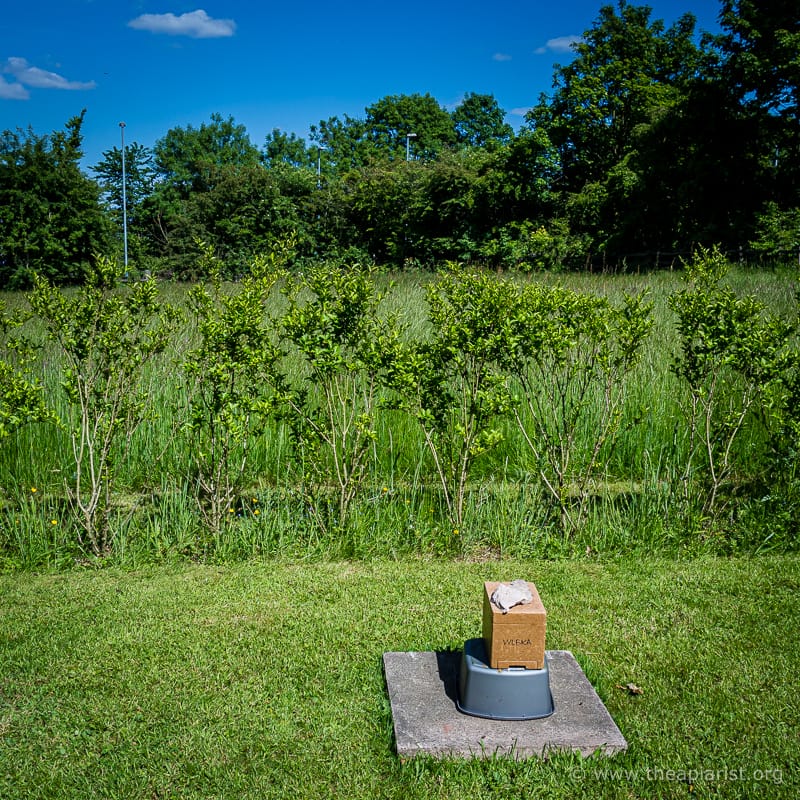
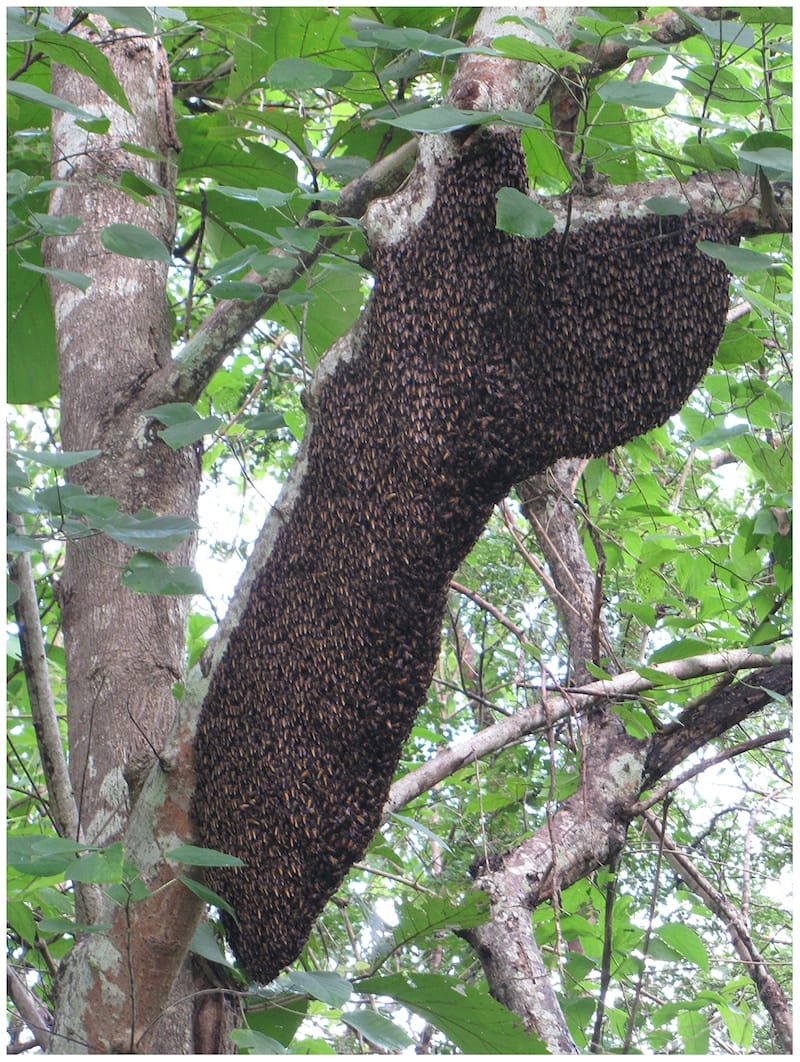
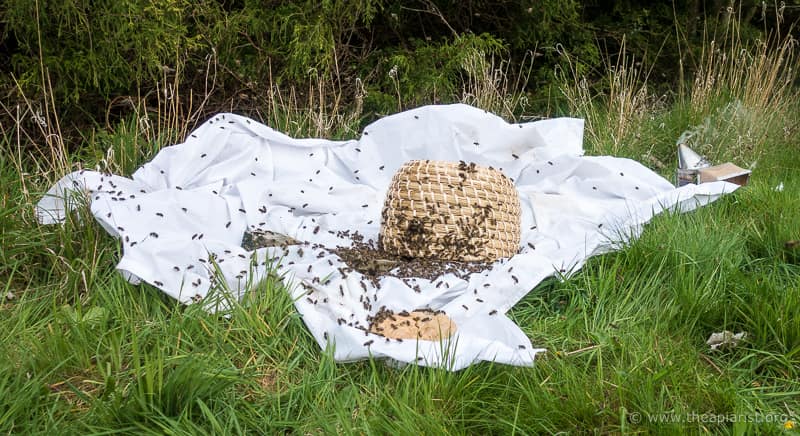
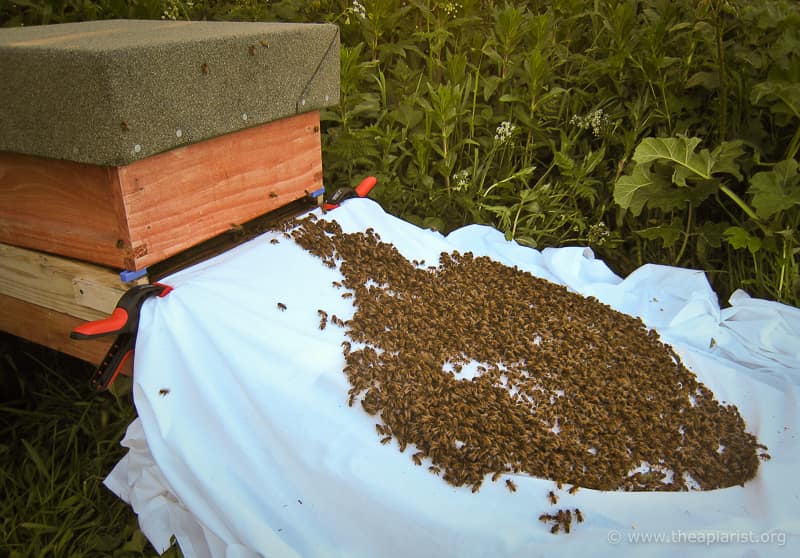
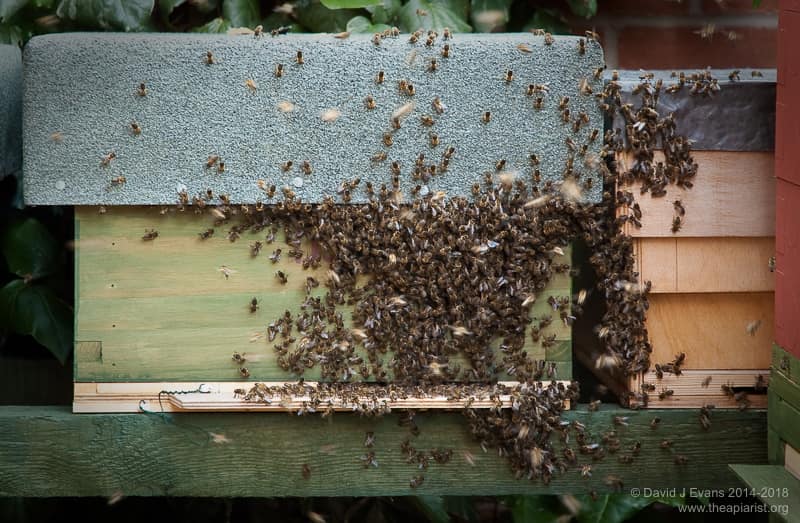
Join the discussion ...